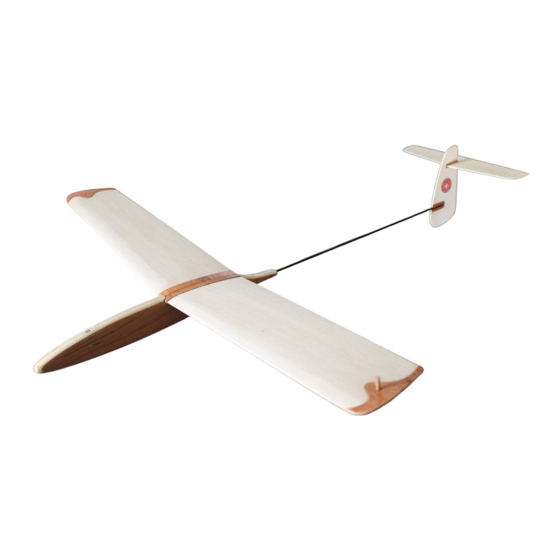Hiesbok Hawk Bauanleitung - Seite 3
Blättern Sie online oder laden Sie pdf Bauanleitung für Spielzeug Hiesbok Hawk herunter. Hiesbok Hawk 3 Seiten. Glider

Stick the two wing sections together and check for correct dihedral whilst the glue dries. Note: place a
block or book under one wing tip and adjust until the correct dihedral value is measured, as shown on
the plans.
Once the wings have fully dried, insert the rear end of the fuselage carbon rod into the front of the
tailplane assembly.
From the front, check the alignment of the wings and tailplane then glue together.
Make any necessary adjustments by rotating the rear section to ensure a perfect alignment with the
front section. This is critical to ensure a fully aligned, efficient airframe.
Allow to fully dry before further handling.
Adjusting the centre of gravity for stable flight:
Note: The centre of gravity is the balance point of the aircraft. For stable flight it is crucial to achieve the
correct centre of gravity in accordance with the position marked on the plans. This position is marked as
an area between two black and white segmented circles on the plans labelled GC. We recommend
marking this location on the actual model to facilitate checking prior to each flight.
Balance the model by inserting the required amount of supplied weights into the hole on the top of the
nose section (the centre of gravity position is marked on the plans). When finished, plug the hole.
For free flight use, the required flight characteristics can be achieved by setting the position of the
ailerons, flaps, rudder and elevator. The wire hinges allow free movement of these control surfaces and
hold them in the desired position during flight.
Always launch the model directly into a gentle breeze or still air.
With the correct center of gravity, if the model noses toward the ground, slightly bend the elevator up
until level flight is achieved.
If the model noses up, correct with a small amount of down elevator.
The model should glide smoothly with a reasonable and pleasing rate of descent.
A tow hook can be screwed into the nose of the model to facilitate launching.
The model can then be launched using about 15m of cord or elastic catapult.
(recommend 5m of quality rubber 3x3mm or 6x1mm and 10m strong cord/nylon).
To launch the model with a circular throw, start by throwing it gently and make any necessary
adjustments before using more throwing force. After adjusting the model, gradually increase the
throwing force to the required level for longer flight duration.
The HAWK model is not a toy. It is important to take great care in constructing the model and in its safe
operation.
Wishing you many successful and enjoyable flights with your new HAWK glider.
Watch out for new additions to our great range of model aircraft kits on our website:
www.craftyproducts.co.uk
